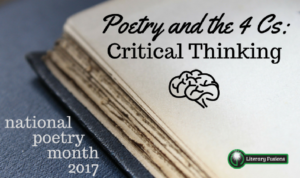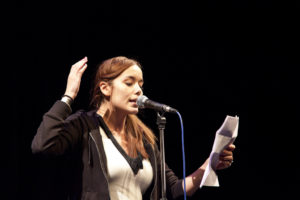 As educators, we know that students’ learning must adapt to accommodate our changing society. No longer can we simply teach “3Rs”: reading, writing, and ‘rithmetic. Our students must be thinkers, problem solvers, and innovators. For them to be these things, they need us to teach them the “4 Cs”: critical thinking, communication, collaboration, and creativity.
As educators, we know that students’ learning must adapt to accommodate our changing society. No longer can we simply teach “3Rs”: reading, writing, and ‘rithmetic. Our students must be thinkers, problem solvers, and innovators. For them to be these things, they need us to teach them the “4 Cs”: critical thinking, communication, collaboration, and creativity.
In honor of April being National Poetry Month, we are excited to bring you a series of blog posts on the 4Cs in poetry. Today’s post will focus on critical thinking. (P.S. This is what we do! We love helping teachers find ways to incorporate innovative teaching strategies into their already existing content! Contact us if you’re interested in a full or half day professional development.)
(Looking for the other 3 Cs? Communication and Collaboration, Creativity – check them out!)
Critical Thinking in Poetry
When students are given a poem, we want them to think critically about the obvious message as well as the implied message. Thinking critically about a poem includes evaluating, analyzing, and interpreting the message, and students must spend plenty of time with the text applying these skills so they are able to explain their interpretations with text evidence. This will not happen overnight or with one lesson! Take your time and scaffold lessons to help students be critical readers of poetry!
The high level of thinking we want from our students will come when they have ample time to practice asking questions about what they are reading, as well as make inferences, and have open discussions about what they are reading. The poem will need to be read many times and there are tools to help! Here are a few:
- Poetry Archive. This site is dense! It’s not a site that is easy to follow and you can get lost – you’ve been warned! However, it’s worth digging into. You can listen to poets read their own works and so much more! There’s something really great about hearing the actual poet read their poem. It’s kind of like going to a rock concert and liking the band even more after you leave! This site has a separate section just for children’s poems. While I hope you will use this section, I don’t want you to stay here! Expose even the youngest child to a classic poem or “adult poem” (within reason of course). While Roald Dahl is my favorite (anyone who knows me knows this!), I wouldn’t want a kid to only hear that type of poem. There is also a section for the teacher. This page has resources, lesson plans, and a collection of poems.

- Poetry Out Loud. Another great site where students can listen to poetry being recited. A huge difference here is that students are reading the poems instead of the author. There is a lot of power in students seeing other “regular” kids reading poems with enthusiasm. Not to mention, this is an interactive site if the students (and you) would like. Your own students could enter contests and competitions. The first section allows you to listen (just audio) or watch videos of the poem being recited. You can also find poems and you are given tips on reciting poems. While on this site, don’t miss the teacher section! It has strong lesson plans to help you teach poetry.
- Poetry Audio Recordings from the Library of Congress. Of course, go to the Library of Congress! This archive has so many great resources. Granted, many are probably more suitable for the older kids, but don’t let that stop you. I use resources like this to get my “teacher brain” flowing! How can I take parts of these sites and get my littles to think critically about a poem? On the site, you can link to thousands (okay, I didn’t count, but A LOT) of sites that would be great for your poetry unit. They also have podcasts. Yes, they are too long for even older students, or, ahem, adults. Don’t run away. Find bits you want and just use that! They also have an archive of poets reading their work, other poems being read aloud, interviews, and more! Check it out!

- Poetry in Commercials. I always believe we should start with where the students are in their learning. Students are exposed to poetry through music and other media, but sometimes don’t realize it. Commercials the kids perk up to usually have a beat or a poem attached. Use those clips to have students think critically about the poem, why the poem was chosen, and how it is helping to sell the product! And now, we are teaching Media Literacy as well! Here are some videos you might like to share: iPad Air, Nike (wings), Levi’s, Sprite, and Nike (soccer).
- For a great list of questions to help you prompt students’ critical thought, check out this site.






This great for our 6th grade G/T students.
Excellent! Please let us know how it goes.
Thank you for the information. I am looking for more research about classic poetry and critical thinking.